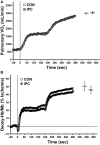Ischemic preconditioning accelerates muscle deoxygenation dynamics and enhances exercise endurance during the work-to-work test
- PMID: 25952936
- PMCID: PMC4463825
- DOI: 10.14814/phy2.12395
Ischemic preconditioning accelerates muscle deoxygenation dynamics and enhances exercise endurance during the work-to-work test
Abstract
Ischemic preconditioning (IPC) improves maximal exercise performance. However, the potential mechanism(s) underlying the beneficial effects of IPC remain unknown. The dynamics of pulmonary oxygen uptake (VO2) and muscle deoxygenation during exercise is frequently used for assessing O2 supply and extraction. Thus, this study examined the effects of IPC on systemic and local O2 dynamics during the incremental step transitions from low- to moderate- and from moderate- to severe-intensity exercise. Fifteen healthy, male subjects were instructed to perform the work-to-work cycling exercise test, which was preceded by the control (no occlusion) or IPC (3 × 5 min, bilateral leg occlusion at >300 mmHg) treatments. The work-to-work test was performed by gradually increasing the exercise intensity as follows: low intensity at 30 W for 3 min, moderate intensity at 90% of the gas exchange threshold (GET) for 4 min, and severe intensity at 70% of the difference between the GET and VO2 peak until exhaustion. During the exercise test, the breath-by-breath pulmonary VO2 and near-infrared spectroscopy-derived muscle deoxygenation were continuously recorded. Exercise endurance during severe-intensity exercise was significantly enhanced by IPC. There were no significant differences in pulmonary VO2 dynamics between treatments. In contrast, muscle deoxygenation dynamics in the step transition from low- to moderate-intensity was significantly faster in IPC than in CON (27.2 ± 2.9 vs. 19.8 ± 0.9 sec, P < 0.05). The present findings showed that IPC accelerated muscle deoxygenation dynamics in moderate-intensity exercise and enhanced severe-intensity exercise endurance during work-to-work test. The IPC-induced effects may result from mitochondrial activation in skeletal muscle, as indicated by the accelerated O2 extraction.
Keywords: Exercise; mitochondria; near‐infrared spectroscopy; nitric oxide; skeletal muscle.
© 2015 The Authors. Physiological Reports published by Wiley Periodicals, Inc. on behalf of the American Physiological Society and The Physiological Society.
Figures



Similar articles
-
Potential physiological responses contributing to the ergogenic effects of acute ischemic preconditioning during exercise: A narrative review.Front Physiol. 2022 Nov 28;13:1051529. doi: 10.3389/fphys.2022.1051529. eCollection 2022. Front Physiol. 2022. PMID: 36518104 Free PMC article. Review.
-
Ischemic Preconditioning Enhances Muscle Endurance during Sustained Isometric Exercise.Int J Sports Med. 2016 Jul;37(8):614-8. doi: 10.1055/s-0035-1565141. Epub 2016 May 13. Int J Sports Med. 2016. PMID: 27176889
-
Effects of ischemic preconditioning on maximal constant-load cycling performance.J Appl Physiol (1985). 2015 Nov 1;119(9):961-7. doi: 10.1152/japplphysiol.00498.2015. Epub 2015 Sep 10. J Appl Physiol (1985). 2015. PMID: 26359484
-
Effect of short-term high-intensity interval training vs. continuous training on O2 uptake kinetics, muscle deoxygenation, and exercise performance.J Appl Physiol (1985). 2009 Jul;107(1):128-38. doi: 10.1152/japplphysiol.90828.2008. Epub 2009 May 14. J Appl Physiol (1985). 2009. PMID: 19443744
-
Methodological Variations Contributing to Heterogenous Ergogenic Responses to Ischemic Preconditioning.Front Physiol. 2021 Apr 29;12:656980. doi: 10.3389/fphys.2021.656980. eCollection 2021. Front Physiol. 2021. PMID: 33995123 Free PMC article. Review.
Cited by
-
Ischaemic preconditioning blunts exercise-induced mitochondrial dysfunction, speeds oxygen uptake kinetics but does not alter severe-intensity exercise capacity.Exp Physiol. 2022 Nov;107(11):1241-1254. doi: 10.1113/EP090264. Epub 2022 Sep 13. Exp Physiol. 2022. PMID: 36030522 Free PMC article.
-
Effects of Ischemic Preconditioning on Sport-Specific Performance in Highly Trained Taekwondo Athletes.Sports (Basel). 2024 Jun 26;12(7):179. doi: 10.3390/sports12070179. Sports (Basel). 2024. PMID: 39058070 Free PMC article.
-
Potential physiological responses contributing to the ergogenic effects of acute ischemic preconditioning during exercise: A narrative review.Front Physiol. 2022 Nov 28;13:1051529. doi: 10.3389/fphys.2022.1051529. eCollection 2022. Front Physiol. 2022. PMID: 36518104 Free PMC article. Review.
-
Ischemic preconditioning and exercise performance: shedding light through smallest worthwhile change.Eur J Appl Physiol. 2019 Oct;119(10):2123-2149. doi: 10.1007/s00421-019-04214-6. Epub 2019 Aug 26. Eur J Appl Physiol. 2019. PMID: 31451953
-
What is the effect of ischemic preconditioning on the kinetics of pulmonary oxygen uptake and muscle deoxygenation during exercise?Physiol Rep. 2015 Sep;3(9):e12540. doi: 10.14814/phy2.12540. Physiol Rep. 2015. PMID: 26341997 Free PMC article. No abstract available.
References
-
- Åstrand PO, Cuddy TE, Saltin B. Stenberg J. Cardiac output during submaximal and maximal work. J. Appl. Physiol. 1964;19:268–274. - PubMed
-
- Bailey SJ, Winyard P, Vanhatalo A, Blackwell JR, DiMenna FJ, Wilkerson DP, et al. Dietary nitrate supplementation reduces the O2 cost of low-intensity exercise and enhances tolerance to high-intensity exercise in humans. J. Appl. Physiol. 2009;107:1144–1155. - PubMed
-
- Bailey SJ, Winyard PG, Vanhatalo A, Blackwell JR, DiMenna FJ, Wilkerson DP, et al. Acute L-arginine supplementation reduces the O2 cost of moderate-intensity exercise and enhances high-intensity exercise tolerance. J. Appl. Physiol. 2010;109:1394–1403. - PubMed
-
- Bailey TG, Birk GK, Cable NT, Atkinson G, Green DJ, Jones H, et al. Remote ischemic preconditioning prevents reduction in brachial artery flow-mediated dilation after strenuous exercise. Am. J. Physiol. Heart Circ. Physiol. 2012a;303:H533–H538. - PubMed
-
- Bailey TG, Jones H, Gregson W, Atkinson G, Cable NT. Thijssen DH. Effect of ischemic preconditioning on lactate accumulation and running performance. Med. Sci. Sports Exerc. 2012b;44:2084–2089. - PubMed
LinkOut - more resources
Full Text Sources
Other Literature Sources

